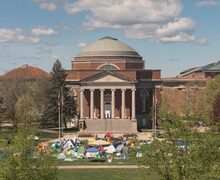The economy of coffee: Economist discusses pros, cons of fair trade products
Fair trade coffee might not be that fair after all.
On Monday afternoon, Arnab K. Basu, a visiting fellow at Cornell University, outlined an experiment he and professors at the College of William and Mary performed that measures the buying patterns of coffees labeled “fair trade” compared to other coffees.
He spoke at length about price premiums: the extra amount consumers will pay to say their purchases will help poor coffee farmers across the world.
“Although theoretically, we should be observing a price premium for products that are labeled,” Basu said, “empirical studies actually show very little or no price premium.”
Basu and his associates decided to create a new test that focused on college students. The test, a paper survey, asks undergraduates about their likelihood of buying different types of coffee with information about price and fair trade or organic labels.
For example, the survey asked students to estimate how much money they spent weekly on coffee and if the “fair trade” label would influence their purchases or not.
Though the survey was completed by nearly 1,000 students at William and Mary, only a handful of students attended Monday’s talk. Outnumbering the students were economics professors who were more interested in the numbers Basu presented than the issues he found with fair trade.
Basu detailed the recent emergence of social obligations that come with purchasing goods, including food, toys or anything else Americans frequently buy. Businesses have increasingly attempted to use labels of socially acceptable causes, such as the absence of child labor, to help promote products.
The coffee industry is an especially pressing issue. Workers in Brazil, which produces more than 55 million bags of coffee per year, face poor working conditions, such as low pay and long working hours. In an effort to support the mistreated workers, some brands have agreed to only sell coffee produced under strict standards, so as to ensure workers are not exploited.
Basu’s group survey first outlined coffee attributes, such as the country of origin, price and whether it is labeled by prominent organizations. It then asked students to identify the product they would be most likely to purchase.
Next, Basu gave a survey to a second group of students that listed the information from the first survey, but with more information about each brand, such as its participation in label programs and revenue guarantees.
After the surveys were finished, the groups collaborated to examine the differences between the answers from each side.
“We picked primarily freshmen and sophomores,” Basu said. “Apart from the fact that they all drink coffee and they are all aware of the fair trade movement is the fact that we automatically controlled for three variables. One is income, they’re all high school graduates and knowledge of economic and social obligations.”
Compared to a similar test performed in Bonn, Germany, Americans are 80 percent more likely to pay more for their coffee because of the fair trade label, the test concluded.
In addition to William and Mary’s survey of 924 students, Basu’s team looked into the background and efficiency of the fair trade movement as a whole.
They found many benefits to fair trade programs throughout the world, such as raising awareness for farmers living in poverty. However, Basu said the organization does not publicize some of its shortcomings.
“The issue is this,” Basu said, “while the fair trade label targets food producers, the label does not provide information on the scale or scope of the program.”
According to Basu, only about 3 percent of poor farmers will significantly benefit from the program, but there isn’t a way to track how much money goes back to the farmers.
Still, Basu said people are attracted to the fair trade movement, so they will not have to change their choices with lesser-quality substitutes. Likewise, the fair trade movement uses coffee as its flagship product because the demand for coffee is exceptionally high and has a guaranteed consumer base, he said.
Another problem Basu observed in the fair trade movement was how difficult it can be for farmers to be eligible to benefit from the program. Most of the time, the poorest coffee farmers will sell to middle men, who then sell fair trade coffee for more than the farmers charged them, to turn a profit. Much of the money that flows through the program does not actually end up in farmers’ hands.
At the end of his presentation, Basu suggested that fair trade must promote more equality for its members to improve its outreach. He also suggested that consumers in the United States increase their own awareness of the inequalities that fair trade often creates: Buying regular coffee could do just as much good.
Said Basu: “Once you give people information and you alert people to the idea that buying unlabeled coffee could be a good thing, then something interesting will happen.”
Published on April 23, 2013 at 2:21 am
Contact Vincent: [email protected]






